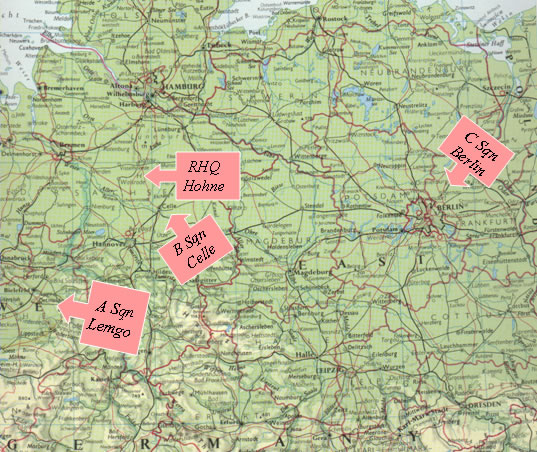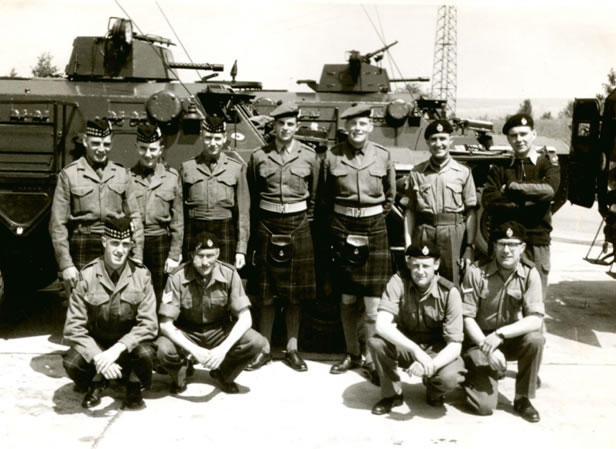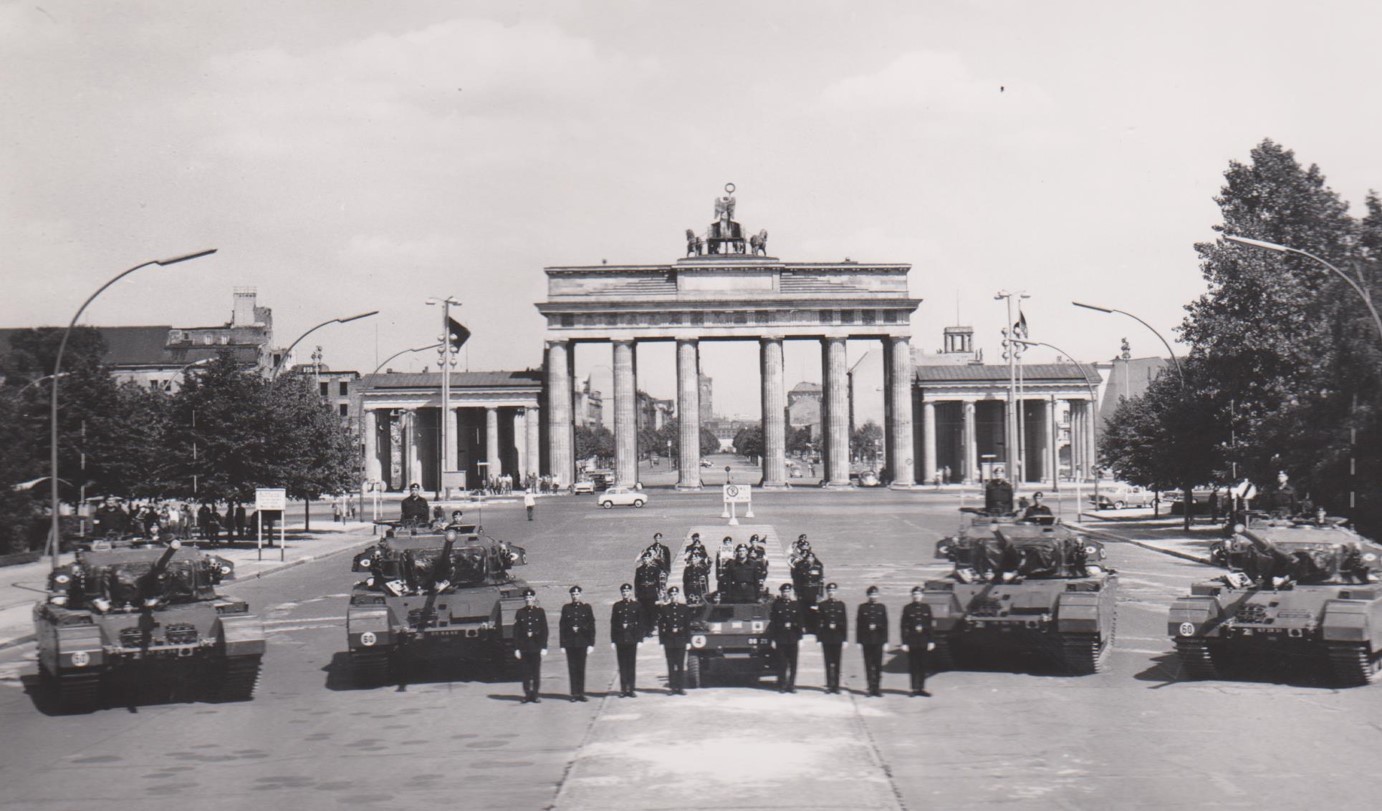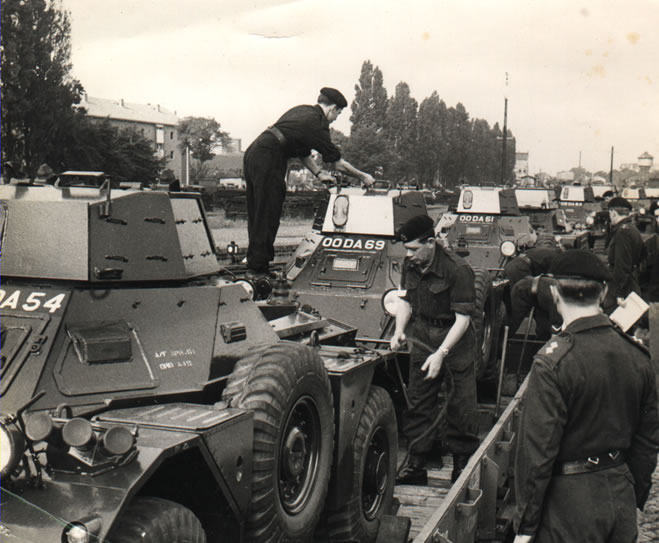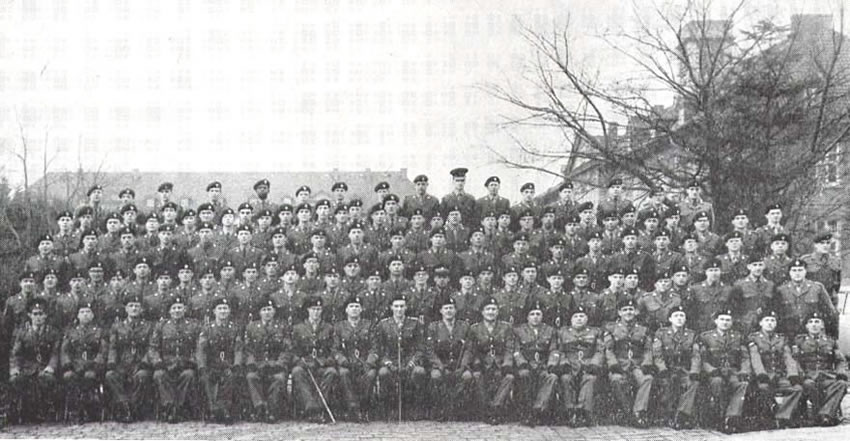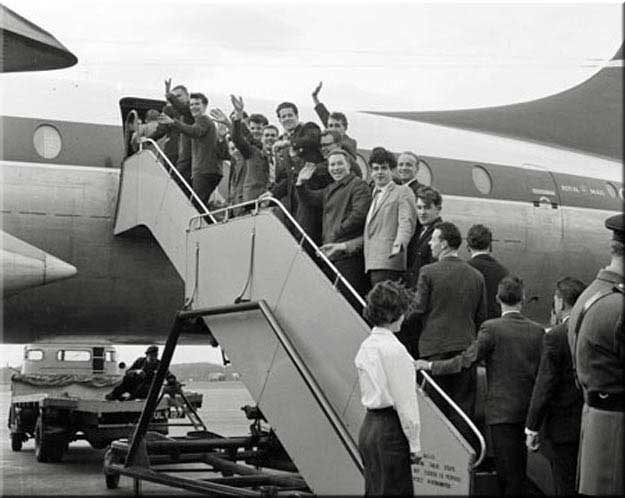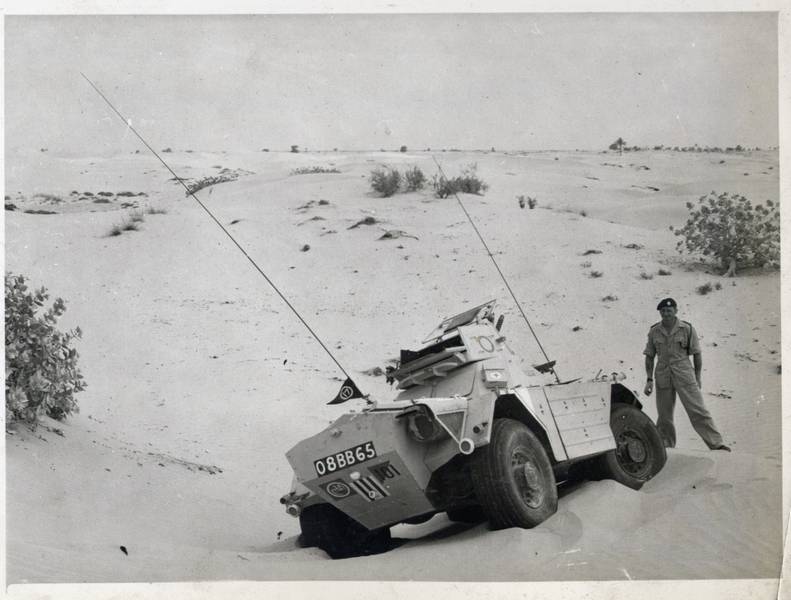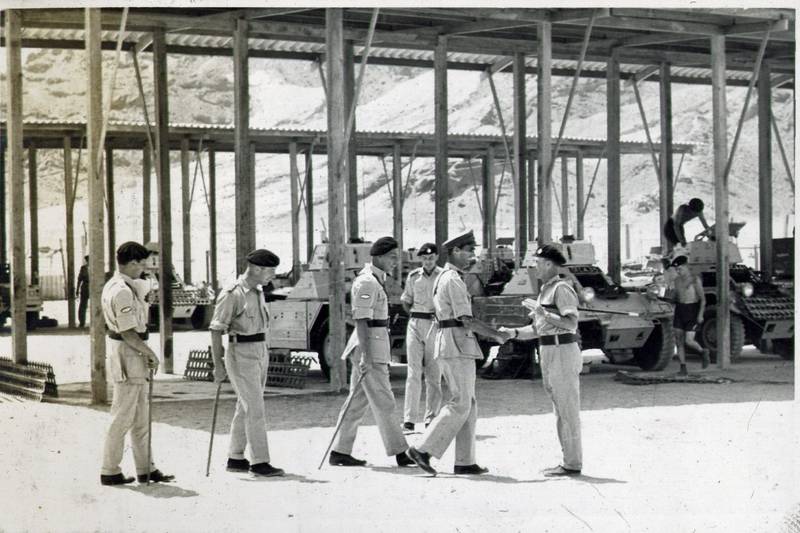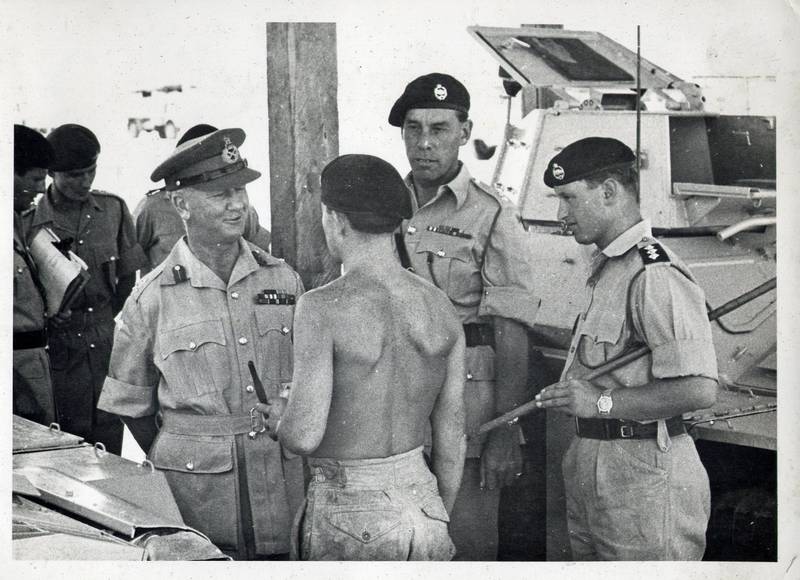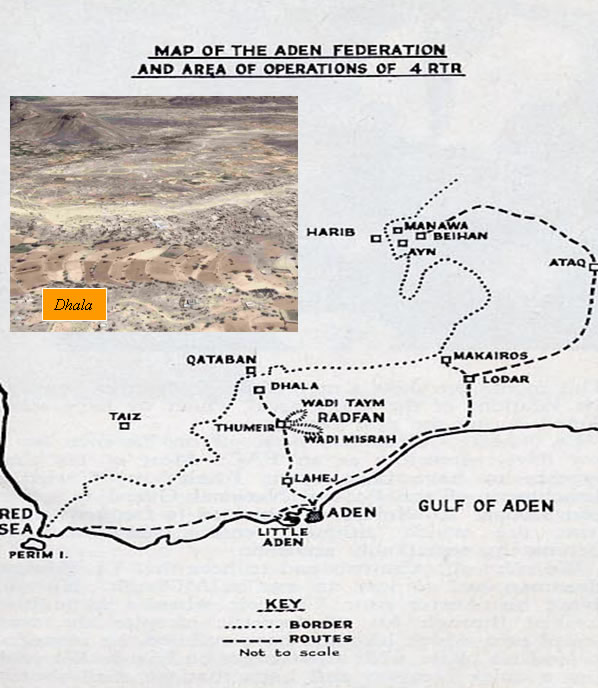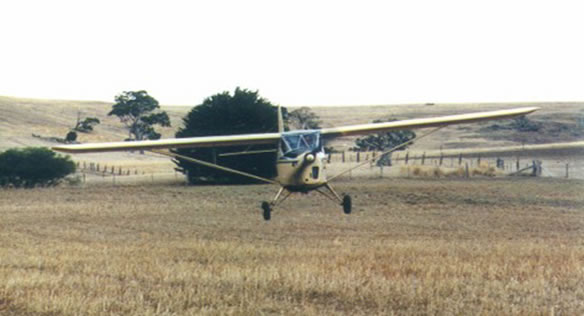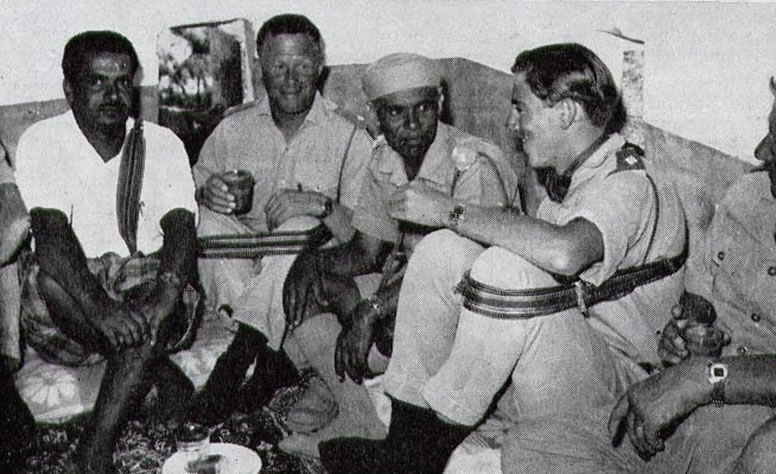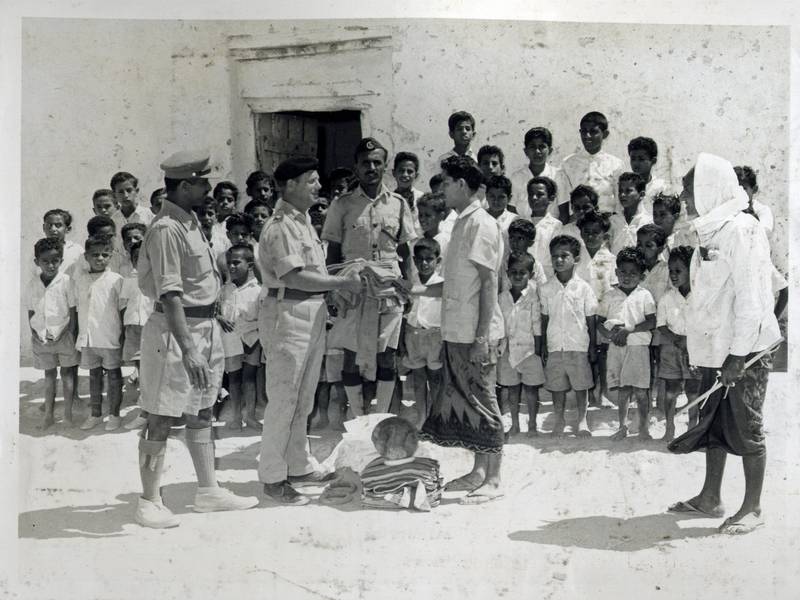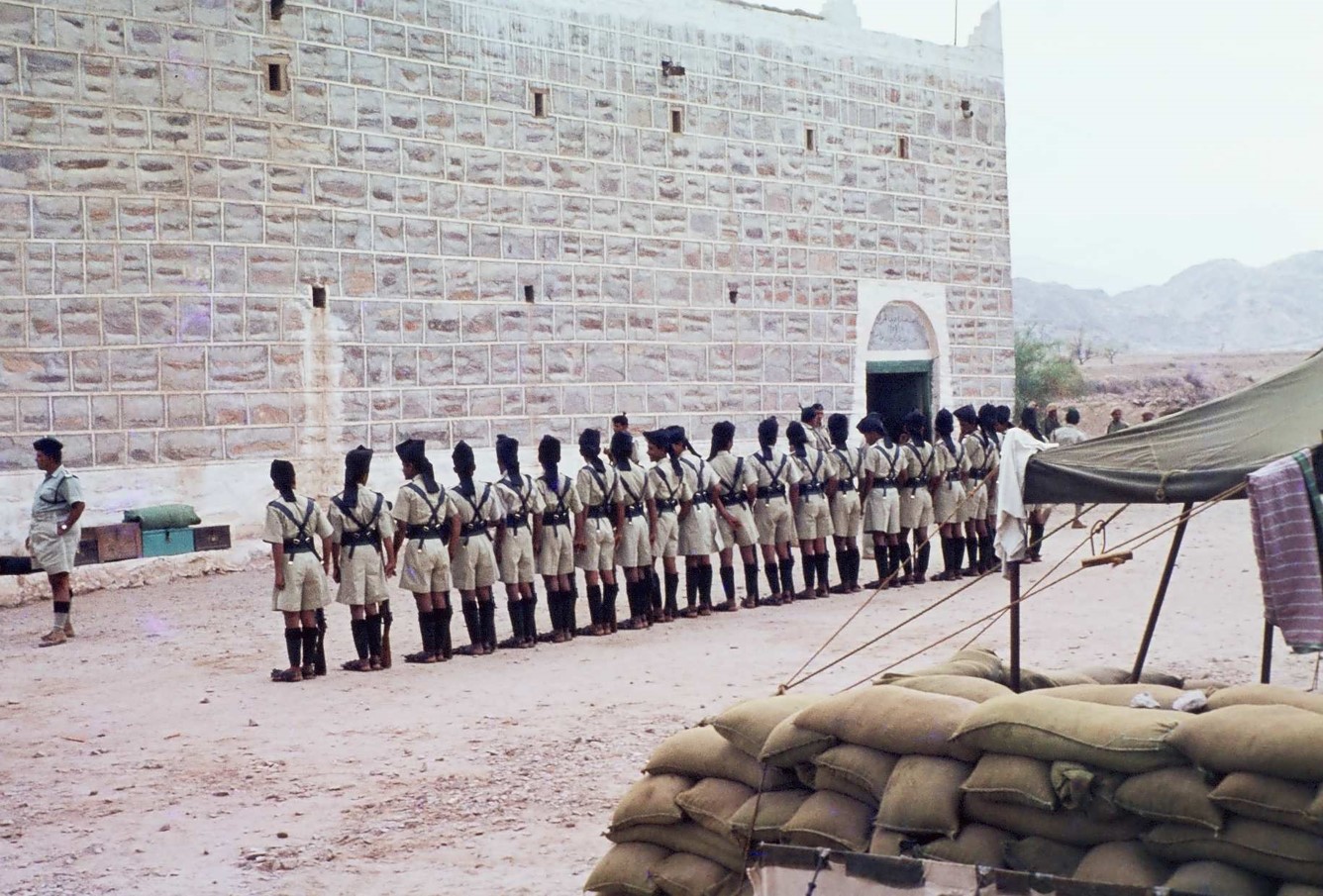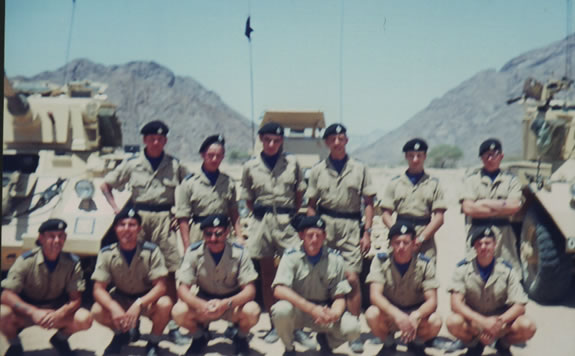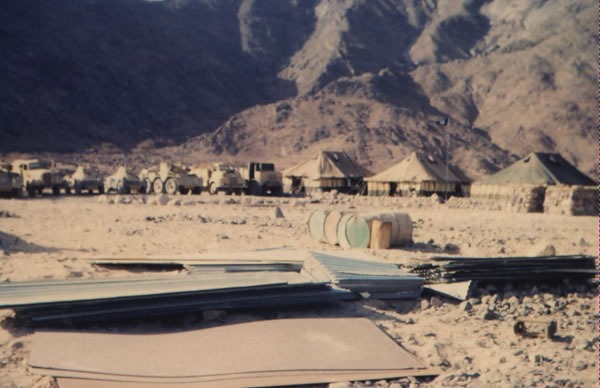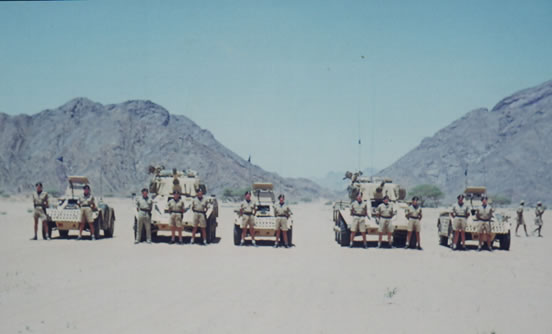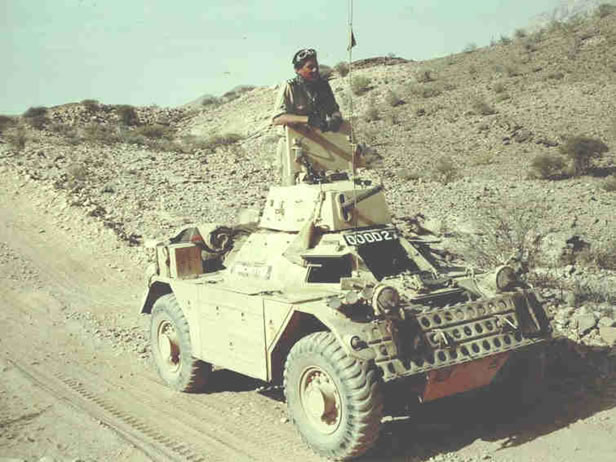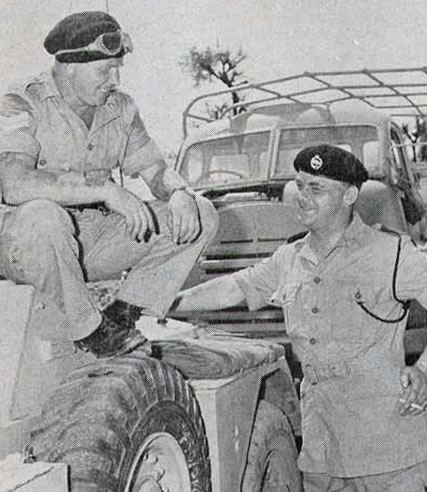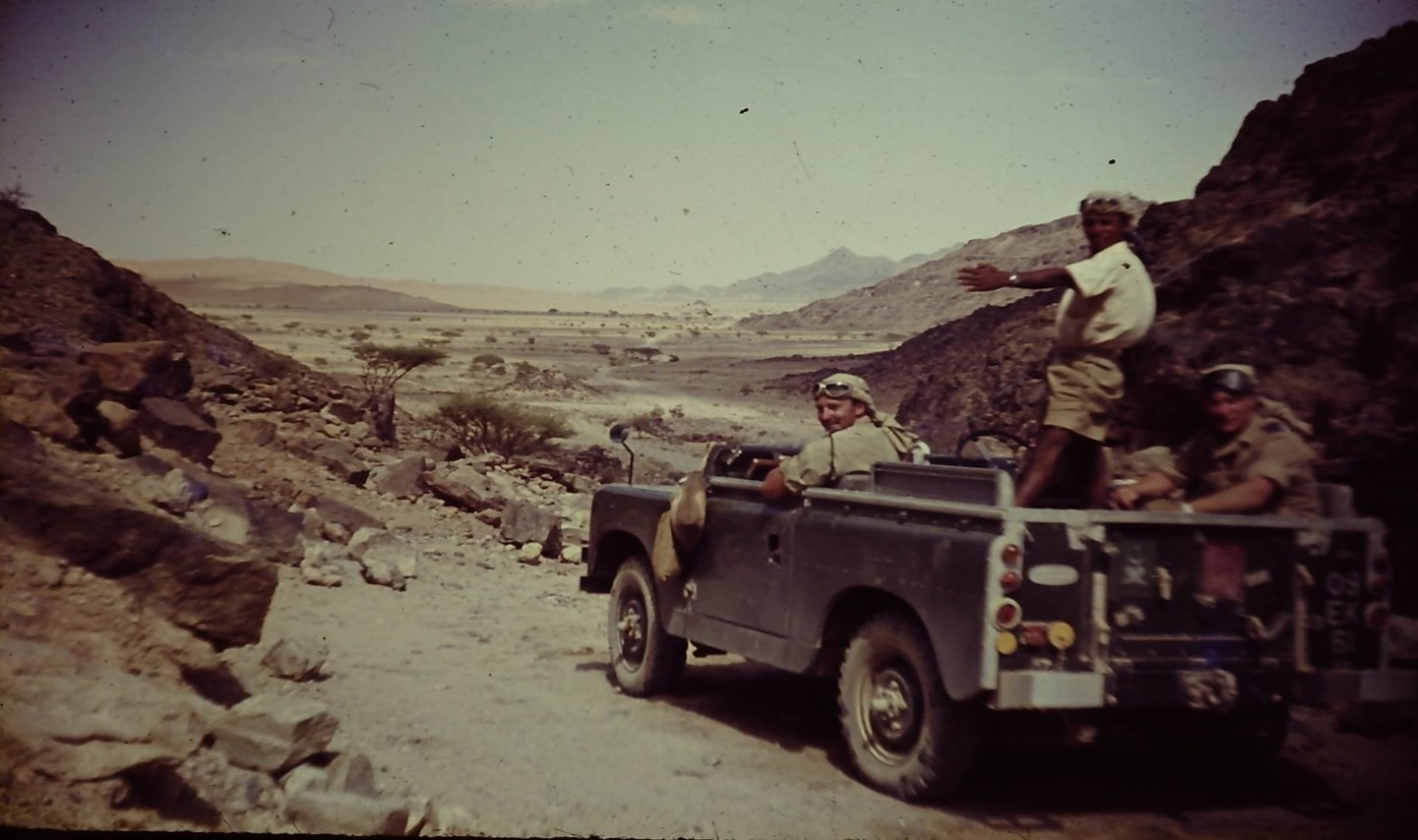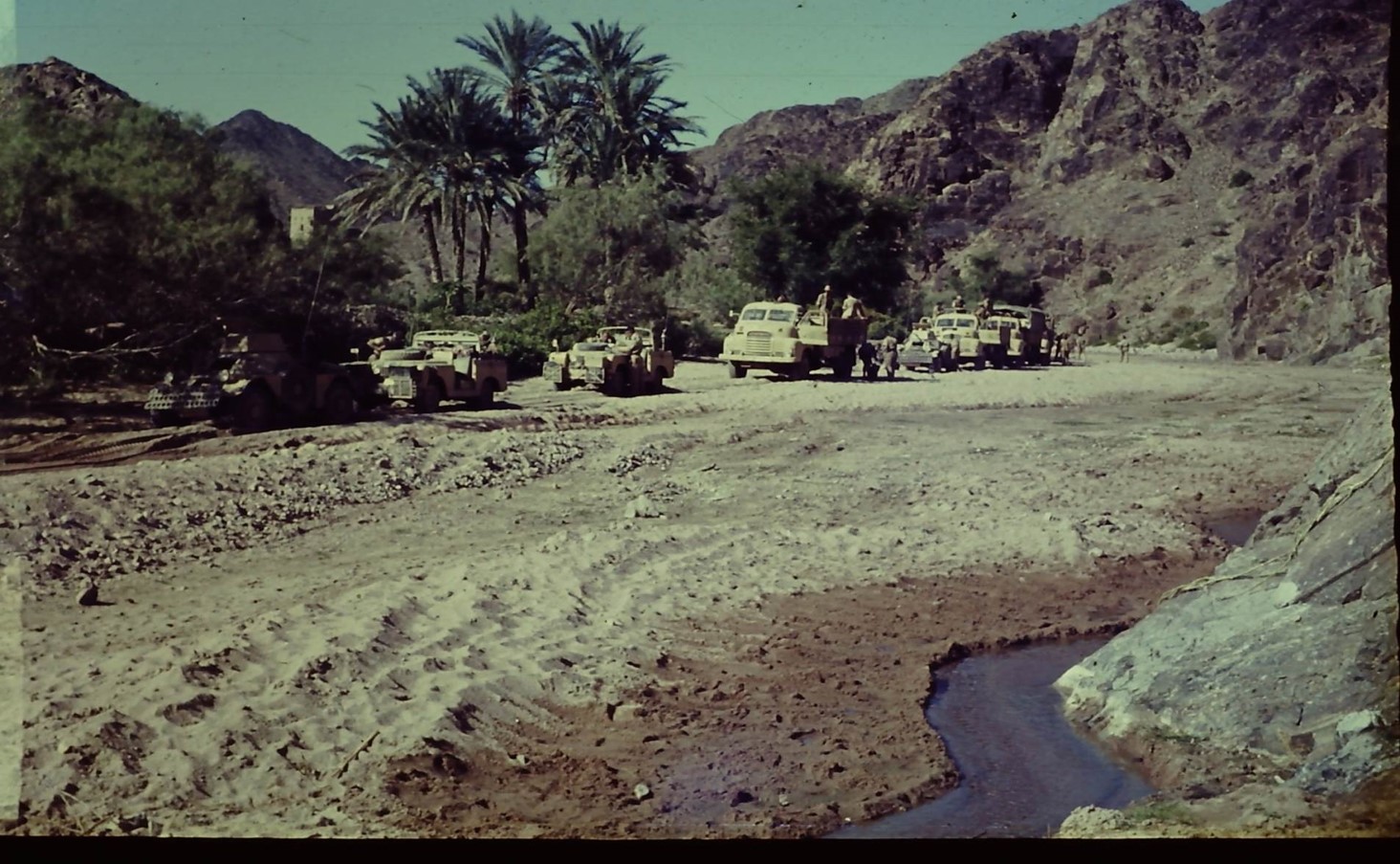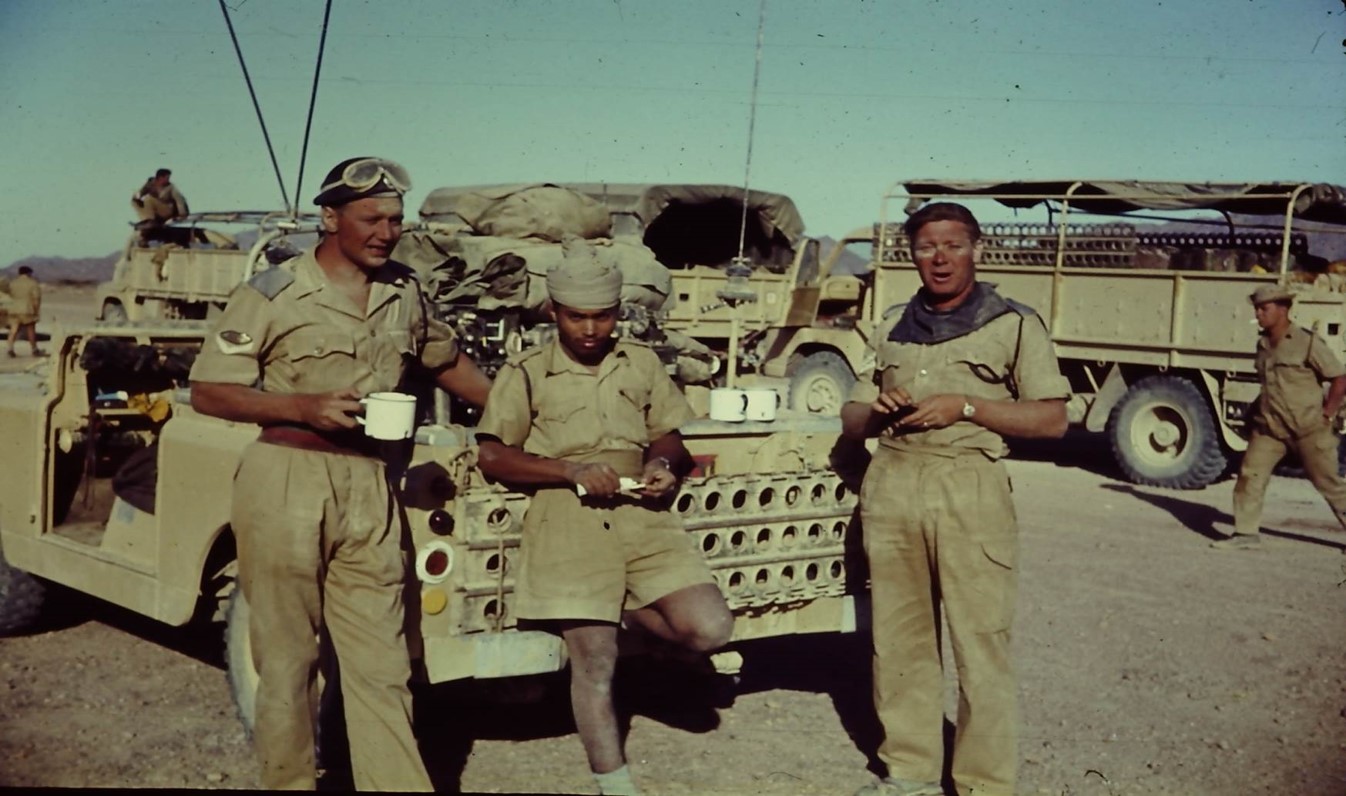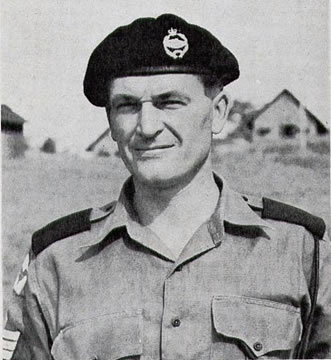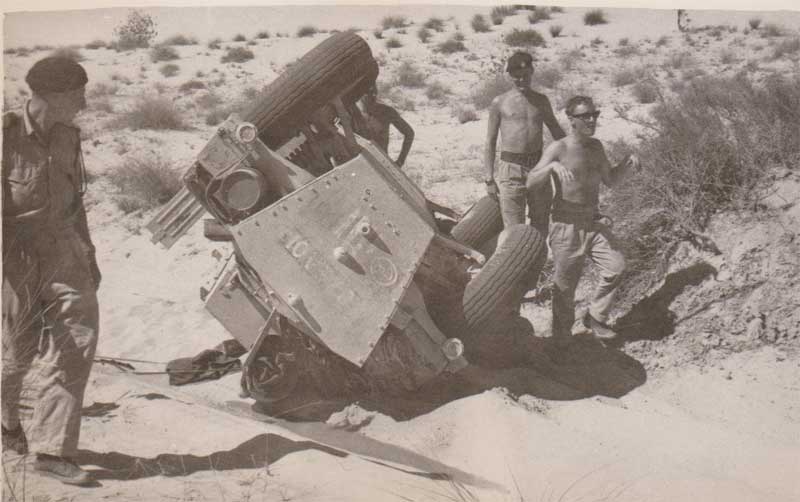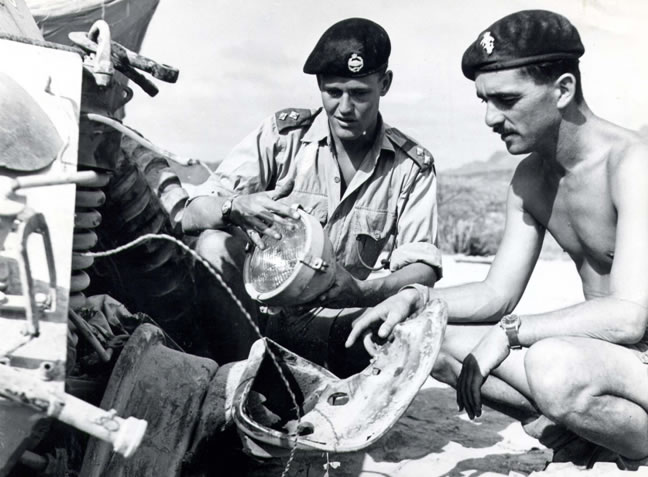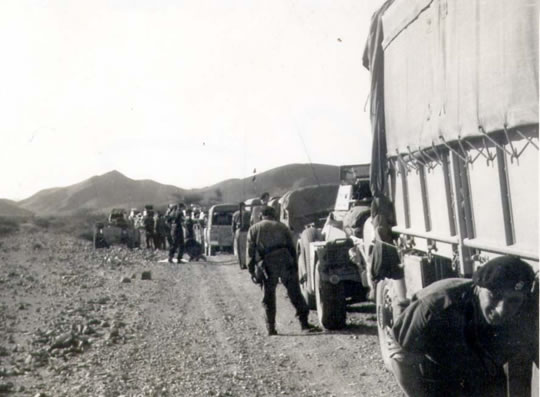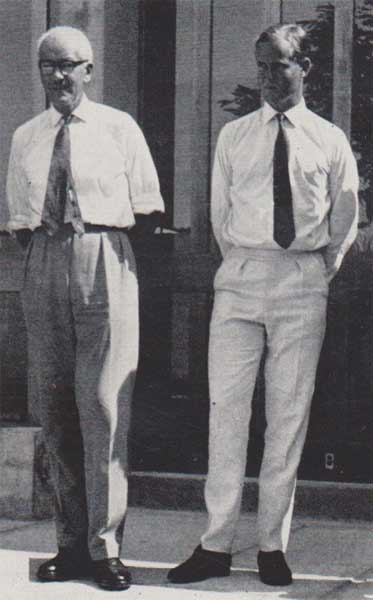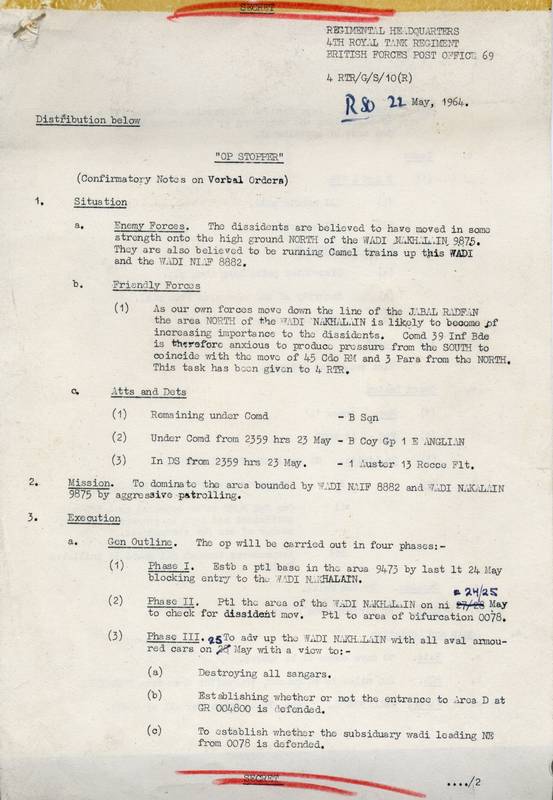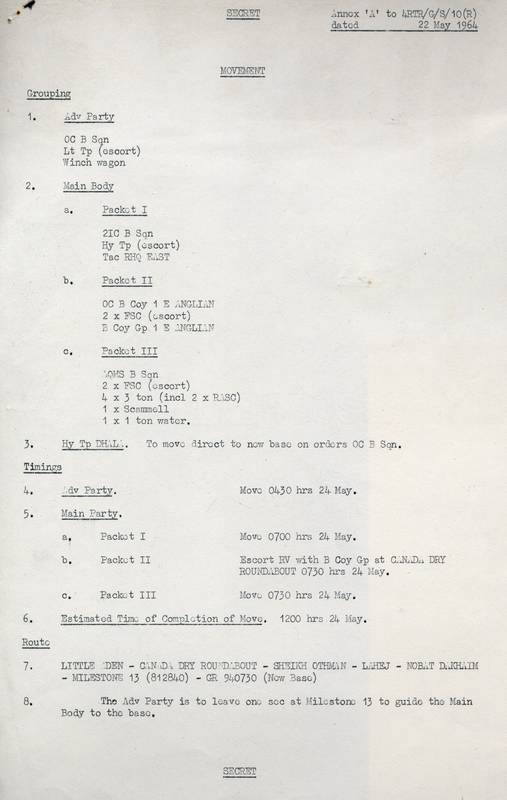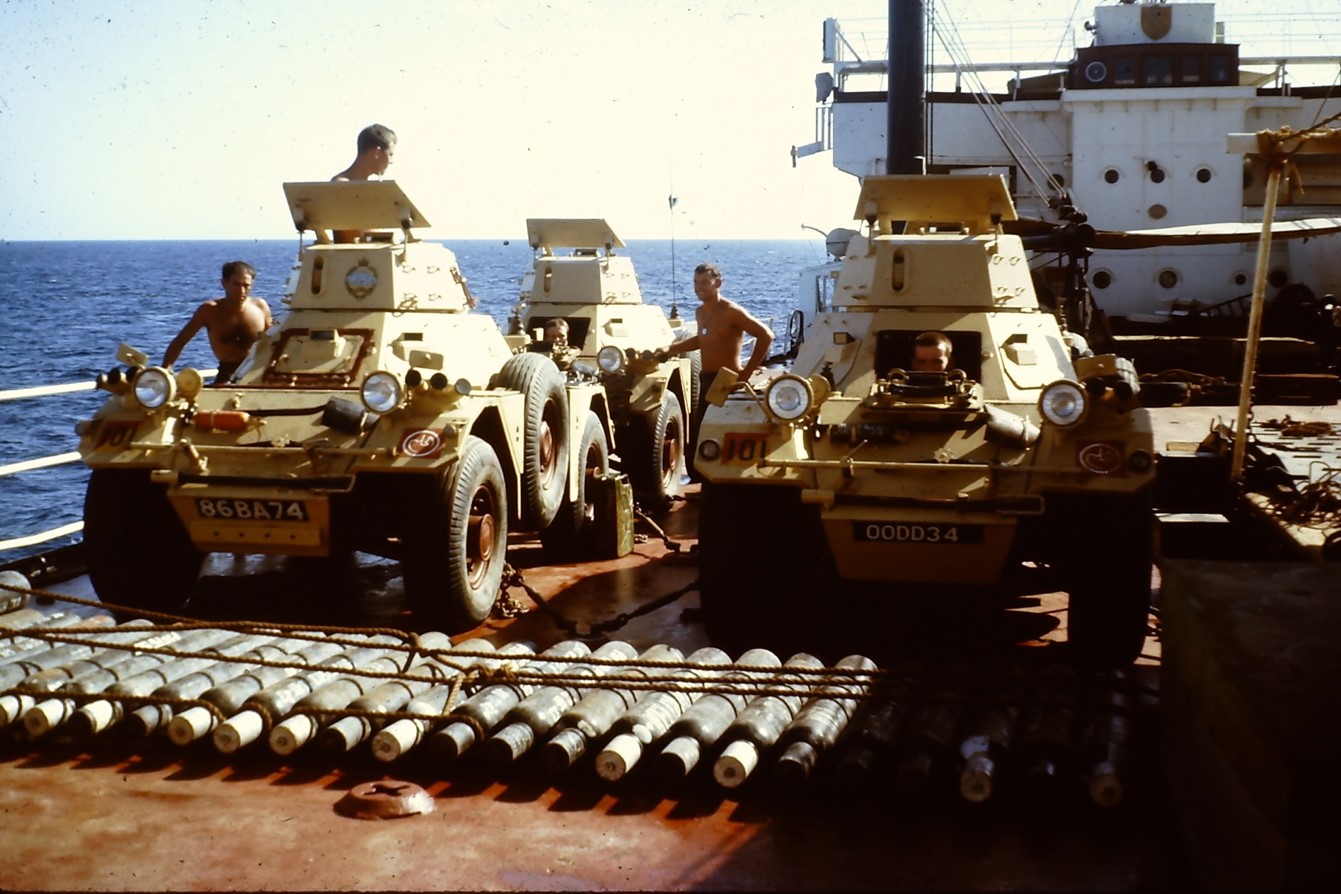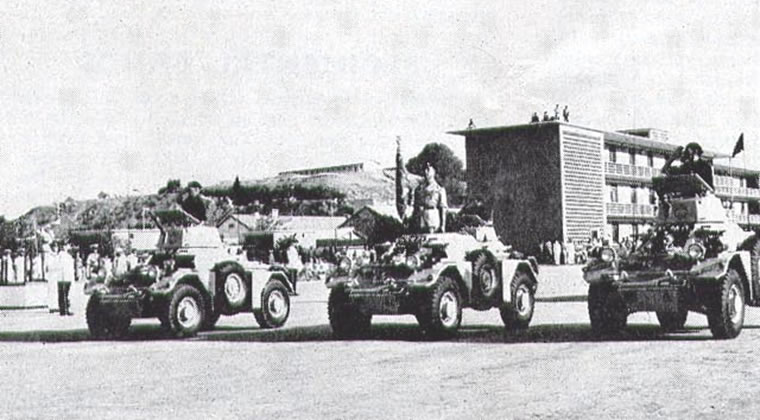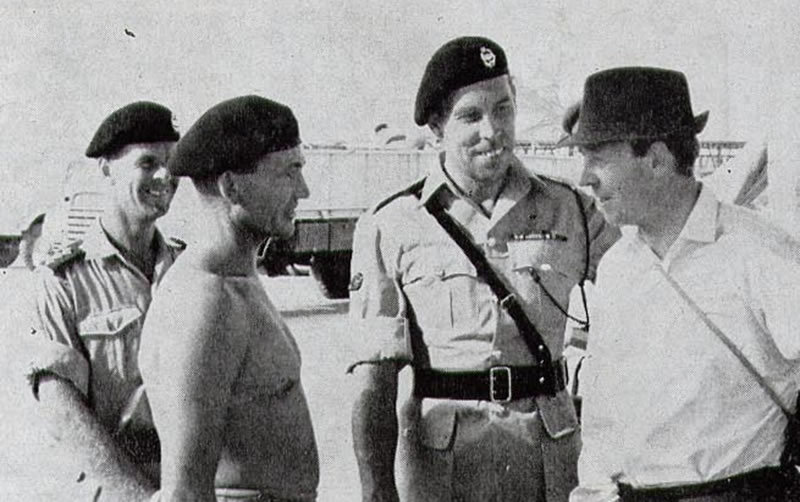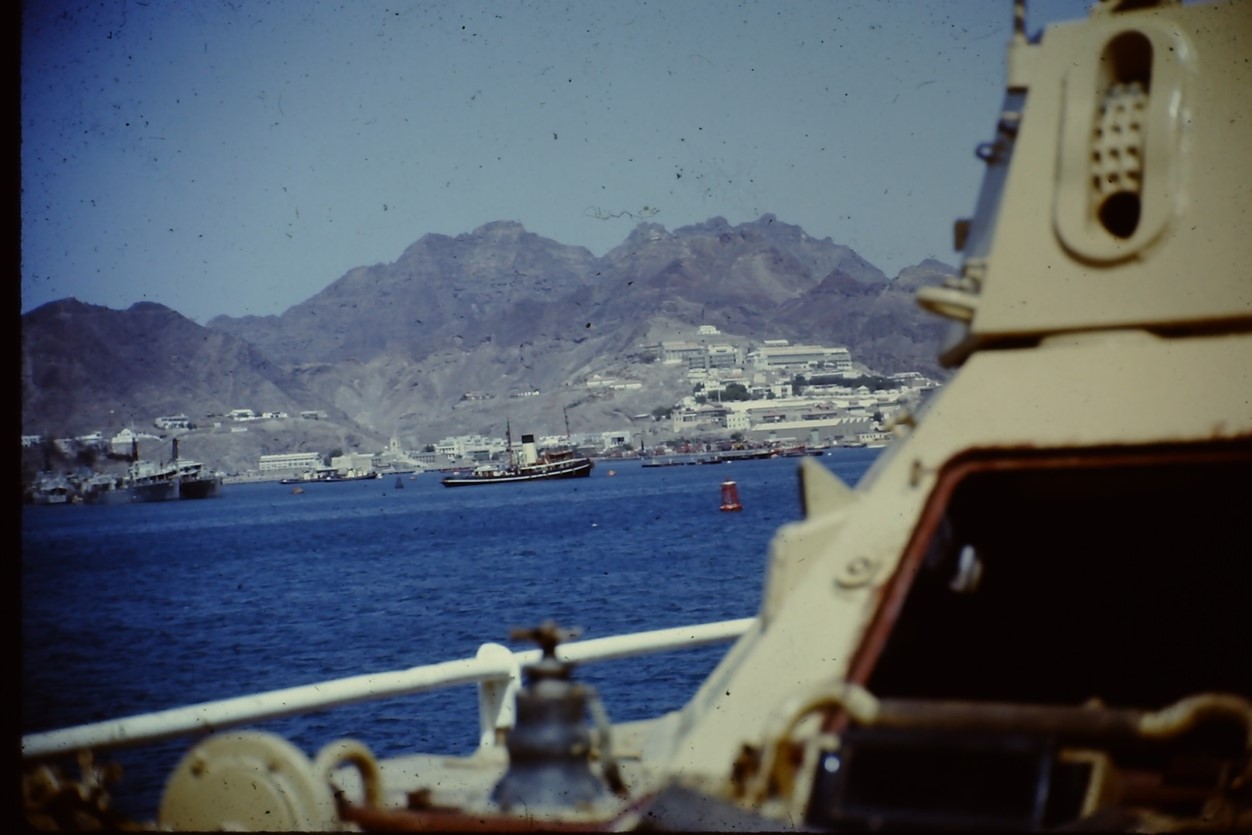1961 – 1964
In early November 1961 The Regiment changed to the APC/Berlin Role. Sqn Comds were Majors Macksey (A), Wilde (B) and Gingell ( C ). Each Sqn had its administrative elements co-located.
A Sqn – Major Ken Macksey MC, who handed over to Maj George Forty in 1962, was deployed to Lemgo as part of 20 Armd Bde and in support of 1 A and SH.
Front S/Sgt Barnes, SSM Chesher, Major Ken Macksey MC, Sgt Ainsley.
Centre Sgts McLeod, Robinson,Hynson and Hibbert
Rear Sgts Benham, Hodges, Bray, Limes,Bassham,
| GOC Berlin inspects “Crews Front” | Captain John Maxwell – C Sqn 2i/c. | The Berlin Squadron joined with the Americans and the French as the following images show. | |
 |
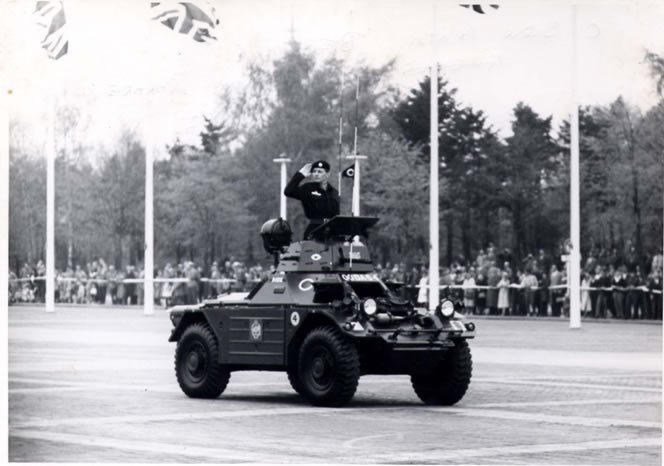 |
 |
 |
| The Drive Past by 11 Regiment de Chasseurs à Cheval. | |||
 |
 |
 |
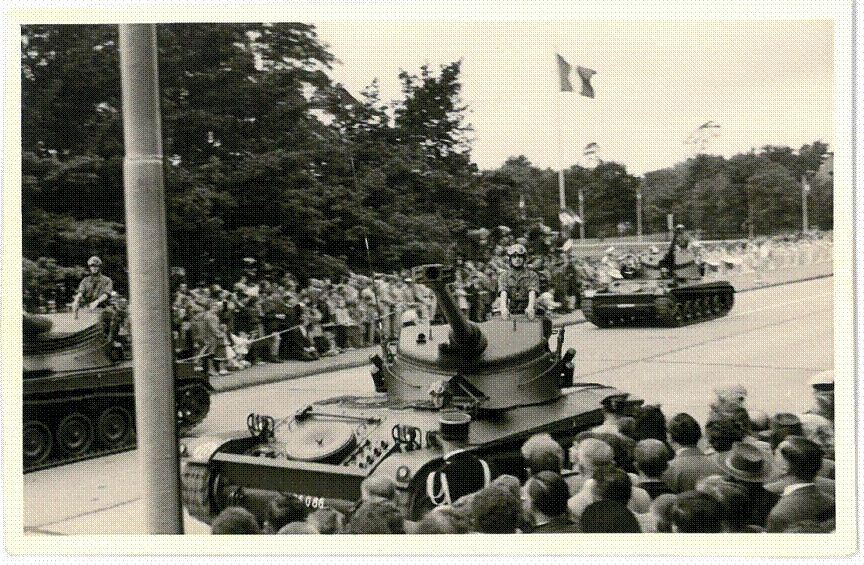 |
In January 1962 there was time for the whole of RHQ troop to go skiing for two weeks with the French Army (159th Bn de la Neige). Adjutant Capt New, Asst Adjt Lt Hardman.
But from February 1962 the APC sqns, although remaining deployed in Lemgo and Celle, reverted to under command 4 RTR which once again became a 1 Div unit.
Rear Lts Rose,Wright, Puren, Rawlins, Carver, Galloway
Centre, Capt Bubb, Lts Van Berkel, Izatt, Capts Kan, Norman,Cocking,Lts Hardman, Drake , EMELET,
Front, Capt O Flaherty, Majors Forty, Dey MBE, Wilde MC, Lt Col Craig OBE MC, Capt New, Maj Attoe, Capts Joyce, Maxwell
March 1963 saw all squadrons leaving their respective bases in Germany. This is a farewell photograph of B Sqn (Capt J.D.F. Alexander)
| In March 1963 the Regiment, now under command Lt Col H B C Watkins MBE, left BAOR after 9 years and moved to Redford Cavalry Barracks, Edinburgh. |  |
| Intensive armoured car training began.
It was good to be together again. |
 |
While in Edinburgh the Regiment mounted guard on the Castle for fourteen days, the first time a non-kilted/trewd regiment had done so.
VCGS, General Sir William Jackson, visits the Regiment in Scotland just before departure for Aden, here talking with the CO, Major G.Forty and Sgt Kaczmar.
The Regiment, less C Sqn deployed in Sharjah, was based in the BP Camp in Little Aden, with A and B Sqn rotating between Little Aden and the Radfan. The original Staff List was as shown.
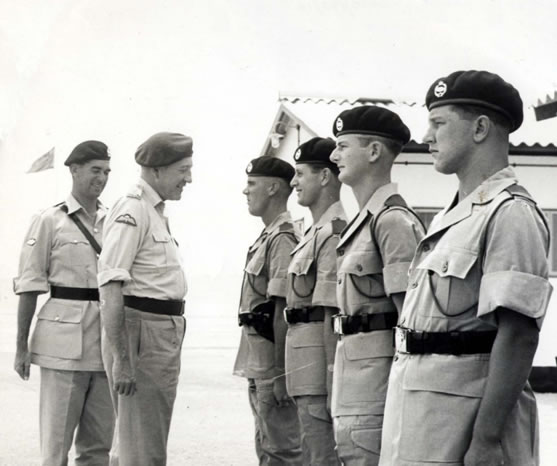 |
 |
C Sqn 4 RTR (Major T.S.M. Welch left) were soon established in Sharjah in support of the Trucial Oman Scouts.
13 Troop cooling off in a wadi between Sharjah and Muscat. Sgt Ford and Tps Merriman, Leslie, Durno, Dalgliesh and Rowland
4 RTR (-) was based at Little Aden. But within days of their arrival they were in action up-country in support of the Federal Regular Army (FRA) against the Egyptian-inspired, National Liberation Front dissidents.
The first month in Little Aden also saw a major repainting and refurbishment of the Camp. RSM L A Smart looks reasonably happy with the result, just in time for the first visit of General Sir Charles Harrington, C in C Middle East.
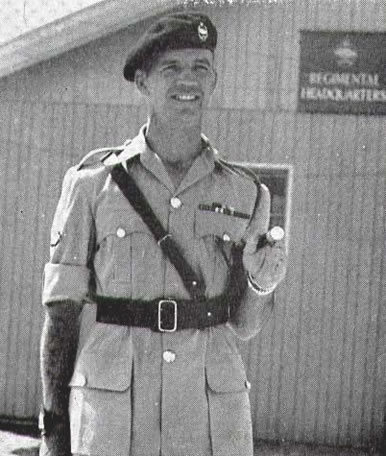 |
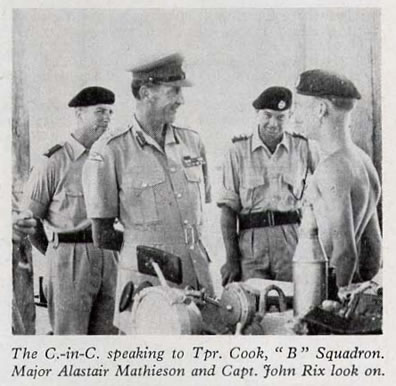 |
Brigadier Harbottle, (commander Aden Garrison) is another early visitor, seen here with L. to R. Capt Cocking, Maj Mathieson, the CO, Capt Rix, and SSM Saunders.
A and B Sqn were committed from Little Aden to the Radfan and Beihan areas in support of the FRA against the increasingly active Egyptian-backed, Communist-supplied dissidents. The Regiment was very widely dispersed. Communication from RHQ was mostly by HF radio using Morse key.
The first to draw dissident blood from direct fire action was Lt Ian Galloway’s troop at Beihan, followed closely by Lt H.B.C Coombes and Sgt Wheatley’s troop at Thumeir.
Distances were so great that squadrons relied increasingly on support from the air for re-supply and movement by Scout, Beaver, RAF Beverley and by DC3s of Aden Airways.
 |
 |
 |
The weekly Pay Day was complicated because the Regiment was so wide-spread. Major Mathieson arrives at Ataq Fort with the gelt. Lt Robinson and Capt Weeks are keen attendants! Capt Goldney the pilot.
The Regiment had an integral flight of Austers for recce and liaison. One of the Auster pilots, Lt Edward Hardman 4 RTR, lost an eye when a bird struck and fractured his canopy. He subsequently managed to land his Auster and save his passenger. He was awarded a well deserved Queen’s Commendation for Valuable Service in the Air, (London Gazette 23 October 1964)
Throughout October and November 1963 A and B Sqn were in action from their forward bases at Dhala, Thumeir Airstrip, Beihan and Fort Ataq. But there was time for 9 Tp B Sqn to challenge the Ataq locals.
 |
 |
Lt Mike Rose’s 7 Tp (Two Saladin, two Ferret and a Morris 1 ton water bowser) were responsible for patrolling Wadi Manawa, on the border with North Yemen . Re-supply was weekly by track to Beihan some seven hours each way. The tour in this very basic outpost was for four months.
While in this detached location the late Mike Rose showed great gallantry which he never subsequently mentioned to RHQ. Some locals contacted him with news that a booby trap grenade had been placed in the local mosque by the Yemenis and requested his help. Mike cleared the area around the mosque and then entered alone. He saw the IED on the mosque floor; it was held down by a rock. Next to it was the firing pin of the grenade which he reinserted making the grenade safe. He then lifted the rock and grenade, went outside and threw it into the cleared area. Thereafter the local Dhala tribe accorded Mike and his troop great deference and cooperation.
By his outstanding bravery he saved the lives of the local tribe and by his action pacified the local area in the early stages of the Radfan campaign.
The camp at Wadi Manawa. The main problems apart from the heat were water supply and mines. On one occasion a German Teller mine blew the wheel station from one of the Saladins, it was jury rigged and, fitted with a Saracen wheel station. It was operational again within three days. Not bad some 450 miles distant from the nearest recovery vehicle!

The Squadron fitters were hundreds of miles from the Regimental LAD (workshops) and had to improvise repairs.
Lt Ian Galloway with his bearer and driver Ali Hamid pointing the way, and Lt Davy Hudson, emerging from the Queen of Sheba Pass into Wadi Ayn.
During a long patrol led by Major Rowley Morris (standing centre with Sgt Jim Hynson) down through Wadi Habban towards the Eastern Aden Protectorate, Capt Tony Weeks checks the map.
Echelon vehicles were especially prone to mine attack. Note the hastily improvised helipad for casevac.
In February 1964 the Commander of the FRA, Brig James Lunt, ordered a withdrawal from wadis held in the Radfan and it was during this difficult extraction phase that Sgt T E F Silverson distinguished himself, leading his ferret troop with great skill and personal courage; for this action he was awarded the Military Medal.
It was a source of very great encouragement at this demanding time to receive this letter from our outgoing Representative Colonel Commandant, Maj Gen HRB Foote, given his exceptional membership of both the 4th and the 7th
By April 1964 there was a clear requirement for three squadrons but only two were available, B and C (A Sqn having taken over from C in Sharjah). Thus it was that D Sqn was formed to carry out the Radfan task, B took over the Beihan area and C became responsible for the Dhala Convoys. Two troops from Sharjah were brought down to add to the deployed Regiment.
RHQ moved up to Thumeir to co-ordinate this activity”.
 |
 |
D Sqn formed up at Thumeir on 4 May 1964, prior to moving off for the second phase of the current Radfan Operation.
13 Troop at work.Lt Jeremy Rawlins,Sgt Ford, L/Cpl Moore and Tprs Merriman, Durno, Leslie, Dalgliesh, Jack, Rowland, Beck, Bourne, Higginbottom
Mines were a constant threat. Lt Jeremy Rawlins and AQMS Robins examine the damage sustained to a Ferret wheel station in the Thumier area.
Next day Lt Rawlins’ troop advanced into Wadi Radfan with a Platoon of 1 Royal Anglian under Lt Long. Encountering a mined road-block an attempt to explode the mines with Saladin 76mm Hesh was followed by the platoon pushing forward. They came under heavy fire and the platoon commander, badly injured, was left lying exposed to fire. Lt Rawlins positioned his ferret to shield Lt Long; he then dismounted, lifted the injured officer on to his back decks under fire and, supporting him there, ordered his driver to reverse out of danger. It was reminiscent of Capt Pip Gardner’s rescue of a KDG officer at Tobruk on 23 November 1941 and earned Lt Rawlins a well deserved Mention in Despatches.
A scratch brigade under Brig R L Hargrove was now ordered to “end the opposition of the dissidents”. C Sqn ( temporarily under Captain David Linnaker) was ordered to escort the convoys that were establishing a stockpile of ammunition, fuel and supplies at Thumeir. In 15 days they ran 9 convoys over the 140 mile route (80 miles of which was unpaved) from Aden to Thumeir, where Major Rowley Morris was base commander.
After these experiences Lt Jeremy Rawlins had a spell as ADC to H.E The High Commissioner, Sir Richard Turnbull based at Government House
Major Alistair Mathieson now commanding D Sqn was ordered to set up a fire base in Wadi Rabwa. D Sqn was subjected to mines, road blocks and heavy fire from the ample high ground. It became a major fire-fight costing six wounded.
| Cpl Richard Nichol | 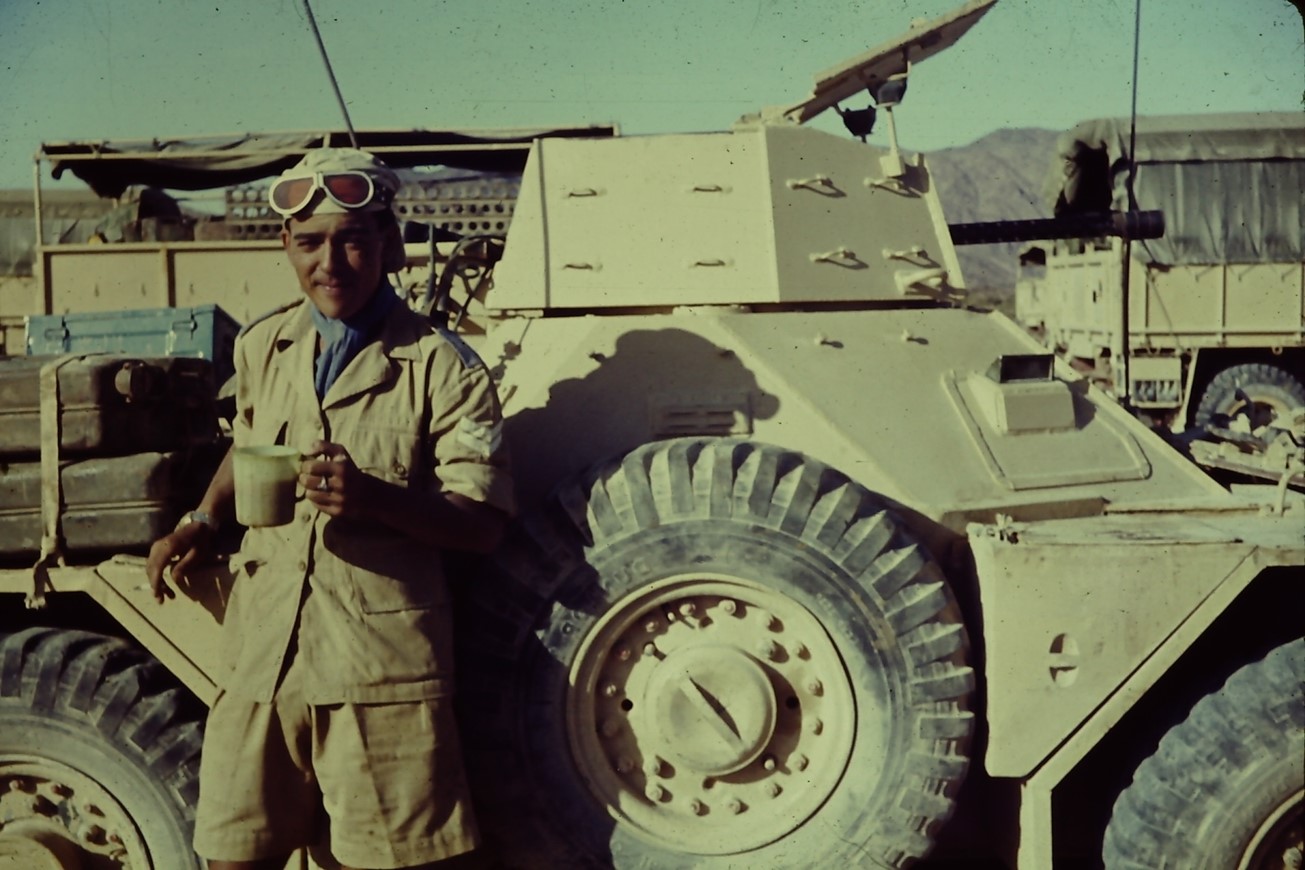 |
| Preparation for the on-coming operation included much ammo-bashing. The Saladin 76 mm HESH ammunition was most effective against sangars. |  |
| Saladins and Ferrets of D Sqn entering Wadi Taym. 300 rounds of HESH and 60,000 rounds of Browning were fired during the operation. |  |
 |
“Watforce” comprised B Sqn RTR (Mathieson), B Coy East Anglians, and supporting elements. The 40 mile approach march to Wadi Nakhalain was completed in one bound on 24 May. The fire fight began at midday 25 May. Tpr Hefferman (arrowed) received a bullet in his back. It was removed by the RMO using a tool from the Fitters tool box; he subsequently drove throughout the day.
 |
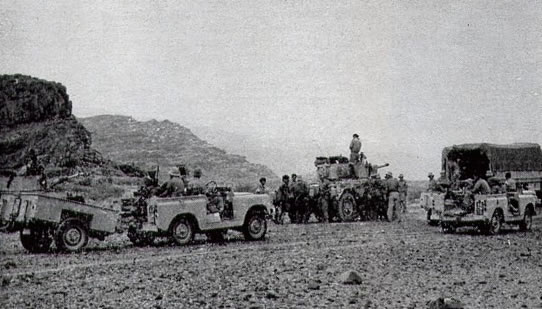 |
Major Alistair Mathieson and Lt Mike Rose (11 Tp) planning an air-strike and tasks for supporting 5.5inch guns on 26 May 1964 as part of the Wadi Nakalain battle. Maj Mathieson was subsequently awarded a Military Cross for his leadership and courage in the WAP. After the battle Mike Rose’s two Saladins had only ten wheels between them.
Five hundred and fifty 76mm HESH rounds fired by the Saladins and countless MMG rounds had ensured that none of the fortifications or sangars survived. By the evening of 26 May the enemy had gone. But it was vitally important that the door be kept closed to prevent further infiltration. This was achieved by intensive patrolling by the Ferret tps working with the Auster AAC flt. L/cpl Clarke and Tpr Hallam were part of the screen.
The Regt was thus widely split by late May. CO 4 RTR was controlling ‘Op Stopper’ with B Sqn in the Radfan; A Sqn was operating in the Trucial States from its base in Sharjah; C Sqn was operating in Wadi Taym from its Thumeir base seen here.
Elements of Watforce were released by 30 May 1964, some to the Aden area where more troops were needed to control a worsening situation. It was time for CO 4 RTR to return to RHQ at Little Aden and gather up some of the strings. We see Tac RHQ 4 RTR here complete with Stalwart echelon leaving the Radfan.
2 Troop being transported from the Persian Gulf back to Aden to assist in the deteriorating situation.
The Crater district of Aden with an average daytime temperature of 36 degrees Centigrade, and a population of some 70,000 nationalist Arabs competing for sovereignty , was part of the problem.
 |
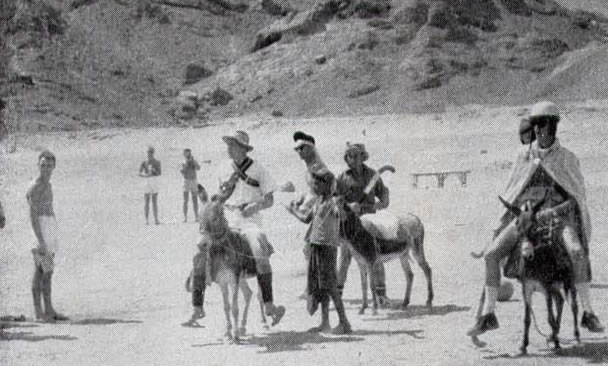 |
But it wasn’t all work. Here a ruthless donkey polo match is played out under the watchful elevated scrutiny of the umpire, SSM Saunders.
The Director Royal Armoured Corps, Major General D’Avigdor Goldsmith, visits the Regiment and receives a confident briefing, as the RSM Bill Bibby, Lt Jeremy Rawlins, Capt David Linaker and Lt Tim Turner (partly obscured) appear satisfied with the content.
17 Tp (Lt Tim Turner) provided the escort for the Standard at the Queen’s Birthday Parade at Little Aden. RQMS Poole carries the Standard, the other Ferrets being commanded by Sgts Jacob and Ford.
The Regiment had been away from its Aden Base for most of May so a combined Queen’s Birthday, belated Arras and ‘farewell to Col Bryan Watkins’ dinner was held in late June in the Officers Mess.
 |
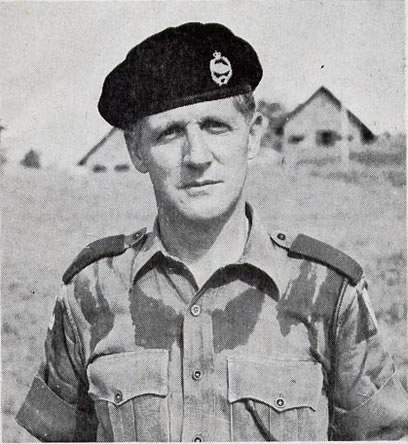 |
Although there
would be no promulgation until the Regiment had left Aden (see next chapter), two further operational awards were won at this stage of operations – Major A.A. Mathieson, the Military Cross (left), and SSM White the MBE.
We must not overlook the unsung heroes of the Regiment, the fitters. Most of them operated hundreds of miles from the LAD, relying on an intermittent radio link for instructions from the EME, Capt Mark Fillingham. Many of the fitters were “B” Vehicle trained yet were dealing with ageing and therefore unreliable “A” vehicles. Only two of the squadrons had Artificers, the remaining relying upon VMs. Yet, having taken over from a Regiment in Aden and Sharjah, which shall remain nameless, with only 50% serviceability (and only 8% in Sharjah) the Fourth scored 76% in the WAP (some being presented for inspection with their barrels still warm from firing!) and 100% in Sharjah one year later with the same vehicles.
On 28 July 1964 Lt Col Bryan Watkins handed over command to Lt Col John Cowgill, fresh from being 2i/c in the First. It was getting quiet in the Radfan but getting noisy in Malaysia where the Regiment was bound next.
18 September 1964.
A signal from the 10th Hussars to the Regiment.
“Many thanks for your good wishes and an excellent handover. Hope fire not hotter than frying pan.”
